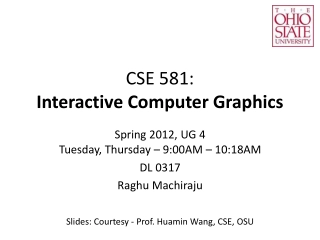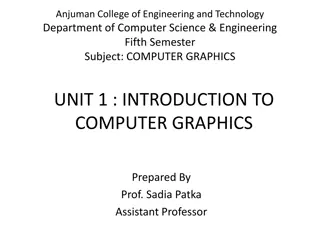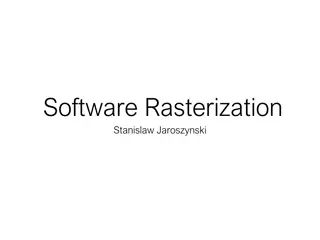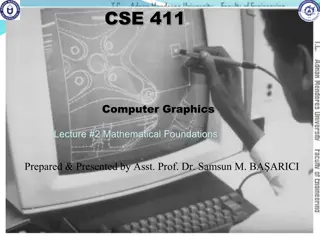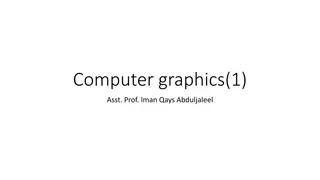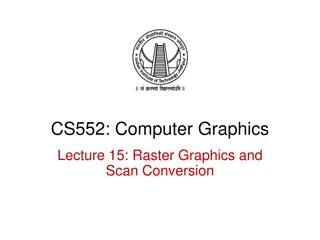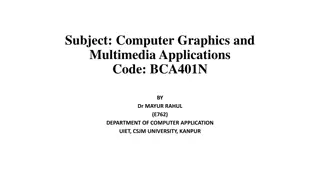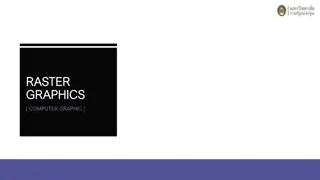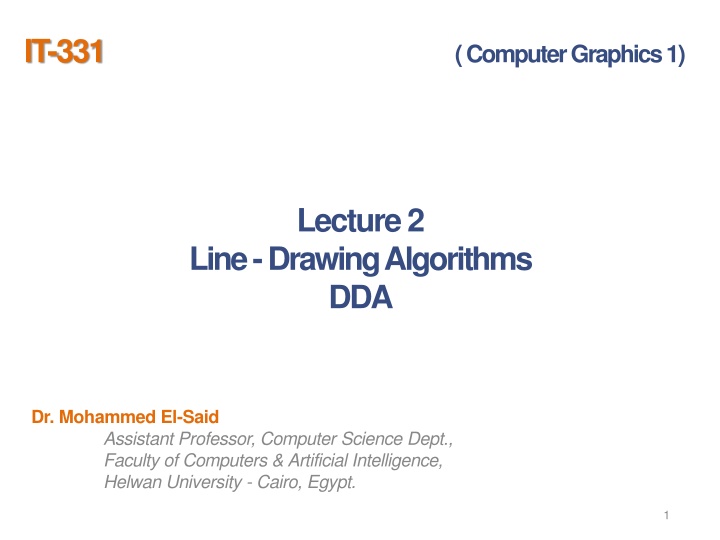
Line Drawing Algorithms in Computer Graphics
Learn about the basic elements, coordinate reference frames, and line-drawing algorithms in computer graphics. Understand how points, vectors, and operators play a crucial role in solving geometric problems in modeling, animation, and visualization. Explore the process of projecting endpoints onto screens, determining pixel positions, and storing color values in frame buffers.
Download Presentation

Please find below an Image/Link to download the presentation.
The content on the website is provided AS IS for your information and personal use only. It may not be sold, licensed, or shared on other websites without obtaining consent from the author. If you encounter any issues during the download, it is possible that the publisher has removed the file from their server.
You are allowed to download the files provided on this website for personal or commercial use, subject to the condition that they are used lawfully. All files are the property of their respective owners.
The content on the website is provided AS IS for your information and personal use only. It may not be sold, licensed, or shared on other websites without obtaining consent from the author.
E N D
Presentation Transcript
IT-331 ( Computer Graphics 1) Lecture 2 Line - Drawing Algorithms DDA Dr. Mohammed El-Said Assistant Professor, Computer Science Dept., Faculty of Computers & Artificial Intelligence, Helwan University - Cairo, Egypt. 1
Basic Elements Two basic elements Points Vectors Points are associated with locations in space Vectors have magnitude and direction represent displacements between points, or directions
Basic Elements Points, vectors, and operators that combine them are the common tools for solving many geometric problems that arise in Geometric Modeling, Computer Graphics, Animation, Visualization, and Computational Geometry.
COORDINATE REFERENCE FRAMES Scan-line algorithms for the graphics primitives use the coordinate descriptions to determine the locations of pixels E.g., given the endpoint coordinates for a line segment, a display algorithm must calculate the positions for those pixels that lie along the line path between the endpoints. Since a pixel position occupies a finite area of the screen the finite size of a pixel must be taken into account by the implementation algorithms. for the present, we assume that each integer screen position references the centre of a pixel area.
COORDINATE REFERENCE FRAMES Once pixel positions have been identified the color values must be stored in the frame buffer Assume we have available a low-level procedure of the form setPixel (x, y); stores the current color setting into the frame buffer at integer position (x, y), relative to the position of the screen-coordinate origin getPixel (x, y, color); retrieves the current frame-buffer setting for a pixel location; parameter color receives an integer value corresponding to the combined RGB bit codes stored for the specified pixel at position (x,y). additional screen-coordinate information is needed for 3D scenes. For a two-dimensional scene, all depth values are 0.
LINE-DRAWING ALGORITHMS A straight-line segment in a scene is defined by the coordinate positions for the endpoints of the segment. 1. To display the line on a raster monitor, the graphics system must first project the endpoints to integer screen coordinates and determine the nearest pixel positions along the line path between the two endpoints. 2. Then the line color is loaded into the frame buffer at the corresponding pixel coordinates. 3. Reading from the frame buffer, the video controller plots the screen pixels. This process digitizes the line into a set of discrete integer positions that, in general, only approximates the actual line path.
LINE-DRAWING ALGORITHMS On raster systems, lines are plotted with pixels, and step sizes in the horizontal and vertical directions are constrained by pixel separations. That is, we must "sample" a line at discrete positions and determine the nearest pixel to the line at sampled position. Sampling is measuring the values of the function at equal intervals Idea: A line is sampled at unit intervals in one coordinate and the corresponding integer values nearest the line path are determined for the other coordinate.
Towards the Ideal Line We can only do a discrete approximation Illuminate pixels as close to the true path as possible, consider bi-level display only Pixels are either lit or not lit In the raster line alg., we sample at unit intervals and determine the closest pixel position to the specified line path at each step
What is an ideal line Must appear straight and continuous Only possible with axis-aligned and 45o lines Must interpolate both defining end points Must have uniform density and intensity Consistent within a line and over all lines What about anti-aliasing ? Aliasing is the jagged edges on curves and diagonal lines in a bitmap image. Anti-aliasing is the process of smoothing out those jaggies. Graphics software programs have options for anti-aliasing text and graphics. Enlarging a bitmap image accentuates the effect of aliasing. Must be efficient, drawn quickly Lots of them are required
Simple Line The Cartesian slope-intercept equation for a straight line is: y = mx + b with m as the slope of the line and bas the yintercept. Simple approach: increment x, solve for y
Line-Drawing Algorithms: DDA Bresenham s Midpoint Algorithm
Algorithms for displaying lines are based on the Cartesian slope-intercept equation y = m.x + b where m and b can be calculated from the line endpoints: m = (y1-y0) / (x1-x0) b = y0 - m. x0 For any x interval x along a line the corresponding y interval y = m. x y1 y0 x0 x1
Simple Line Based on slope-intercept algorithm from algebra: y = mx + b Simple approach: increment x, solve for y Floating point arithmetic required
Does it Work? It works for lines with a slope of 1 or less, but doesn t work well for lines with slope greater than 1 lines become more discontinuous in appearance and we must add more than 1 pixel per column to make it work. Solution? - use symmetry.
Modify algorithm per octant OR, increment along x-axis if dy<dx else increment along y-axis
DDA Algorithm The digital differential analyser (DDA) is a scan-conversion line algorithm based on using x or y. A line is sampled at unit intervals in one coordinate and the corresponding integer values nearest the line path are determined for the other coordinate.
Line with positive slope If m<=1, Sample at unit x intervals (dx=1) Compute successive y values as yk+1=yk+m 0<=k<=xend-x0 Increment k by 1 for each step Round y to nearest integer value. If m>1, Sample at unit y intervals (dy=1) Compute successive x values as xk+1=xk+1/m 0<=k<=yend-y0 Increment k by 1 for each step Round x to nearest integer value.
inline int round (const float a) { return int (a + 0.5); } void lineDDA (int x0, int y0, int xEnd, int yEnd) { int dx = xEnd - x0, dy = yEnd - y0, steps, k; float xIncrement, yIncrement, x = x0, y = y0; if (fabs (dx) > fabs (dy)) steps = fabs (dx); else steps = fabs (dy); xIncrement = float (dx) / float (steps); yIncrement = float (dy) / float (steps); setPixel (round (x), round (y)); for (k = 0; k < steps; k++) { x += xIncrement; y += yIncrement; setPixel (round (x), round (y)); } }
DDA algorithm Need a lot of floating point arithmetic. 2 round s and 2 adds per pixel. Is there a simpler way ? Can we use only integer arithmetic ? Easier to implement in hardware.

